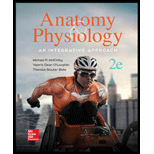
Concept explainers
_____ 1. Which organ is located in the right upper quadrant of the abdomen?
- a. liver
- b. spleen
- c. descending colon
- d. appendix
Introduction:
The liver is an accessory organ that is located in the upper right quadrant of the abdomen. It is located just after the diaphragm. It performs various functions, such as digestion of food and the bile production. It is the largest organ of the human body.
Answer to Problem 1DYKB
Correct answer:
The liver is located in the right upper quadrant of the abdomen. Therefore, option a. is correct.
Explanation of Solution
Reason for the correct statement:
Option a. is given as “liver”. The upper right quadrant of the abdomen is present nearer to the diaphragm and the organ liver is attached to the diaphragm. The liver is found in the right upper quadrant of the abdomen.
Hence, option a. is correct.
Reasons for incorrect statements:
Option b. is given as “spleen ”. The spleen is present to the left of the liver and spleen is present in the left quadrant. So, the spleen is not found in the right quadrant. Hence, option b. is not correct.
Option c. is given as “descending colon”. The descending colon is located in the left quadrant, not in the upper right quadrant. Hence, option c. is not correct.
Option d. is given as “appendix”. The appendix is a part of the larger intestine, it is located in the lower right quadrant, not in the upper. Hence, option d. is not correct.
Hence, options b., c., and d. are incorrect.
The liver is the organ of the abdomen that is located in the upper right quadrant. It is the largest organ of the body and it also removes the toxin from the blood.
Want to see more full solutions like this?
Chapter 26 Solutions
Anatomy & Physiology: An Integrative Approach
- A patient with appendicitis usually has pain in thequadrant of the abdomen.a. left-lower c. left-upperb. right-lower d. right-upperarrow_forwardSelect the letter of the choice that best completes the statement. The lining of the abdominal cavity is calleda. pleural.b. peritoneal.c. submucosal.d. epithelial.arrow_forwardWhich statement is correct? a. The hard palate is anterior to the soft palate b. The hard palate is posterior to the soft palate c. The hard palate is lateral to the soft palate d. The hard palate is medical to the soft palatearrow_forward
- Which organ is NOT supplied by the celiac trunk? Select one: a.spleen b.transverse colon c.liver d.stomacharrow_forwardThe fine lines that are on the mucous membrane are known as A. Mucous membrane B. Vertical lines C. Weather line D. Medial lobearrow_forwardAn inflammation of the lining of the abdominal cavity is calleda. pleurisy.b. pericarditis.c. peritonitis.d. gastritis.arrow_forward
- The tiny prominence that is at the mid-line of the superior part of the mucous membrane is known as the A. Angulaus oris eminence B. Angulus oris sulcu C. Medial lobe D. Mental eminencearrow_forwarddeglutition describes a. enzyme digestion of food in the mouth b. the act of swallowing c. formation of a bolus before swallowing d. chewing foodarrow_forwardThis organ may be part of the immune system and helps prevent infections in the large intestine.a. duodenum c. cecumb. rectum d. appendixarrow_forward
- Rahul recently scheduled a procedure to have his wisdom teeth removed. What system is the oral surgeon most likely going to use to view the xray images of his teeth? A.pharmacy information system B. Radiology information system C. Surgical information system D.dental information systemarrow_forwardThe pancreatic ducts are blocked with a thick, sticky mucus in individuals with the genetic condition called cystic fibrosis. What difficulties will these individuals experience? a. inability to produce mucin b. inability to produce HCl c. insufficient digestive enzymes d. excess production of bilearrow_forwardA patient requiring surgery for severe blunt trauma to the left upper abdomen was admitted. Among the following, which organ is most likely to be affected? Answer Choices: a. Spleen b. Gall bladder c. appendix d. pancreasarrow_forward
 Fundamentals of Sectional Anatomy: An Imaging App...BiologyISBN:9781133960867Author:Denise L. LazoPublisher:Cengage Learning
Fundamentals of Sectional Anatomy: An Imaging App...BiologyISBN:9781133960867Author:Denise L. LazoPublisher:Cengage Learning Medical Terminology for Health Professions, Spira...Health & NutritionISBN:9781305634350Author:Ann Ehrlich, Carol L. Schroeder, Laura Ehrlich, Katrina A. SchroederPublisher:Cengage Learning
Medical Terminology for Health Professions, Spira...Health & NutritionISBN:9781305634350Author:Ann Ehrlich, Carol L. Schroeder, Laura Ehrlich, Katrina A. SchroederPublisher:Cengage Learning

